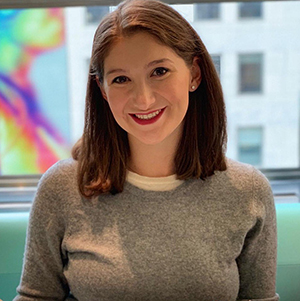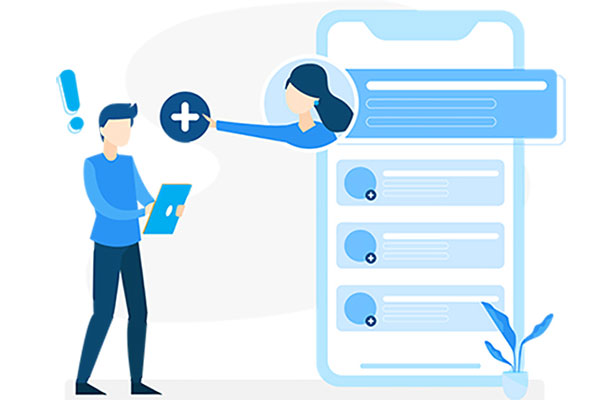ConnectFor enables managers to link employees’ interests and goals with projects
Startup Snapshot: Danielle Boris ’16, MBA ’21, founder and CEO, ConnectFor

A graduate of the Samuel Curtis Johnson Graduate School of Management, Danielle Boris ’16, MBA ’21, is founder and CEO of ConnectFor, a real-time platform that puts employees’ professional interests at the center of project teaming.

After she earned her undergraduate degree in communications at the College of Agriculture and Life Sciences and before starting her Johnson Cornell Tech MBA, Boris worked at BuzzFeed as a market and brand research analyst and went on to be a manager of strategy and partnerships at Noodle.com, then a mobile experience business analyst at Tiffany & Co.
Learn more about Boris and ConnectFor in this Q&A.
What does ConnectFor do? What problem or opportunity does it address?
ConnectFor’s mission is to ensure every employee is given an equal opportunity to love their work. Research shows that women and minorities are statistically less likely to speak up for themselves at work, and, if they do speak up, they are less likely to be heard. Our first product, ConnectFor Work, solves that problem.
ConnectFor Work is the first real-time solution to provide actionable insights to managers on how inclusively they provide opportunity on their team. Our B2B SaaS platform enables managers to course-correct when employees are lacking in opportunities to contribute or are not receiving opportunities that align with their professional interests.
What inspired you to launch ConnectFor?
ConnectFor’s inspiration is the culmination of dozens of interviews of employees of varying industries, after a hypothesis I had based on my own experience as an employee.
The ConnectFor story begins right after I graduated college. I liked my first job, but was quickly ready for the next challenge. After networking internally, I was able to move around within the company, but I soon realized that every time I got up the gumption to raise my hand for projects that interested me, I was met with initial enthusiasm, but no real progress. Others were getting those projects, and I felt less inclined to raise my hand after these experiences happened cyclically, even though I knew I was the right person for the project.
I realized that I am indeed someone who does speak up, and yet not everyone does. And I started to connect the dots more when I began the Johnson Cornell Tech MBA program. In his class on leadership, Allan Filipowicz, clinical professor of management and organizations, helped me realize further how the obstacles of speaking up for oneself at work stem from how teams are managed and motivated, in addition to biases that exist. I set out to further understand how I could tap into employees’ intrinsic motivation at work, help them consistently feel empowered at work, and give them ownership over their careers while helping managers tap into their teams’ unlimited potential.

And that is when the wheels really started to turn to create ConnectFor.
What are some of the most memorable moments in your startup journey?
Hands down, some of my first moments with ConnectFor were born during my experience at Cornell Tech. Pitching in the finals of Cornell Tech’s Entrepreneurship competition was a fantastic experience. I honed my pitch, presented to hundreds of people, and learned how to engage with an entirely virtual conference audience. But I have to also say that my most memorable experiences come from working with my Cornell Tech Studio team. I am grateful for the brilliant minds who joined me for eight months as we worked to make ConnectFor a reality, including Haonan Jing and Anu Deodhar, both MEng ’21 (Computer Science), and Jennifer Barry, MBA ’21.
What obstacles did you face and overcome in your startup journey?
Starting a business during the pandemic has its silver linings; but I will tell you, it is most certainly a tricky time so many of us are contending with. I began working on ConnectFor in May of 2020. My entire experience building ConnectFor with my team was, and remains, virtual. I quickly learned how to manage a team during the most unprecedented time of our lives, while also balancing a virtual MBA experience. We managed so much at one time, but in retrospect it really made us stronger as a business and truly gives more energy around our mission to help employees and managers work together for long-term benefit.
Did you draw on any Cornell resources to help launch ConnectFor?
Indeed I did, and I believe those resources continue to bolster ConnectFor.
Cornell Tech’s studio program was integral to launching ConnectFor. Through the class I was able to build an amazing team, learn fundamentals about launching a business, and receive direct support from the studio teaching team through countless one-on-one meetings. Additionally, many of the Cornell Tech classes are project-based. My professors allowed me to use ConnectFor as the basis for my classwork. In Mukti Khaire’s class, Building Entrepreneurial Ventures, I created the business plan for ConnectFor. Similarly, in Values at Play with Professor Helen Nissenbaum, I created a model for ethically collecting and storing data within the platform. Mukti Khaire further helped me by advising my independent study project, where I researched and wrote a literature review titled “Interest and Autonomy: A New Model for Improving Employee Engagement.” This research allowed me to prove that the model for ConnectFor is, in fact, supported by the literature. Finally, over the summer of 2021, I was accepted into the Johnson Summer Startup Accelerator run by Ken Rother and was able to work with my wonderful entrepreneur in residence, Susan Fleming, MS ’08, PhD ’10 (Johnson), on challenges I was facing with the company. She provided guidance on how to approach these problems and supported me in my unfortunately unique position as a female founder.
Is there any particular faculty member who influenced you on your path to becoming an entrepreneur?
I knew I wanted to pursue entrepreneurship when I applied to Cornell Tech. Mukti Khaire and Josh Hartman were both incredibly influential in helping me achieve that goal and make it a reality. The additional guidance from the studio team further helped make ConnectFor a reality.
What are the most valuable things you learned at Cornell that helped in launching ConnectFor? And what’s most helpful now, in running your new business?
The phrase “seek first to understand” comes to mind. Cornell Tech’s studio curriculum is based on a research-first approach. This method teaches that the best way to pursue any idea is to first understand the users’ needs and then continually test assumptions of your solution through the building process. I continue to use these methods today, and they heavily align with my own research background and research-first approach to business.
What advice do you have for other aspiring entrepreneurs?
Two things.
One, I firmly believe that nobody can accomplish anything alone. Thus, I am grateful for my team at Cornell Tech who helped me create the first versions of ConnectFor. Because of them, I was able to hire brilliant and creative talent after graduation.
Second, if you’re looking to start a company, start by talking to people about their experiences in the space you are interested in. Forget your idea and listen to their experiences, and, when possible, go watch how people live in the environment you are developing in. Once you formalize your idea, keep testing different assumptions and pivoting until you find what works best for your users. Put your ego aside.
Oh, and one more. Most importantly: Surround yourself with a team of people who are trustworthy and smarter than you. Believe in their unlimited potential.
